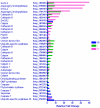Gene expression patterns in larval Schistosoma mansoni associated with infection of the mammalian host
- PMID: 21912711
- PMCID: PMC3166049
- DOI: 10.1371/journal.pntd.0001274
Gene expression patterns in larval Schistosoma mansoni associated with infection of the mammalian host
Abstract
Background: The infective schistosome cercaria develops within the intramolluscan daughter sporocyst from an undifferentiated germ ball, during which synthesis of proteins essential for infection occurs. When the aquatic cercaria locates the mammalian host it rapidly penetrates into the epidermis using glandular secretions. It then undergoes metamorphosis into the schistosomulum, including replacement of its tegument surface membranes, a process taking several days before it exits the skin. Patterns of gene expression underlying this transition have been characterised.
Methods and principal findings: All gene models from the S. mansoni genome (www.GeneDB.org) were incorporated into a high-density oligonucleotide array. Double-stranded cDNA from germ balls, cercariae, and day 3 schistosomula was hybridised to the array without amplification. Statistical analysis was performed using Bioconductor to reveal differentially transcribed loci. Genes were categorised on the basis of biological process, tissue association or molecular function to aid understanding of the complex processes occurring. Genes necessary for DNA replication were enriched only in the germ ball, while those involved in translation were up-regulated in the germ ball and/or day 3 schistosomulum. Different sets of developmental genes were up-regulated at each stage. A large number of genes encoding elastases and invadolysins, and some venom allergen-like proteins were up-regulated in the germ ball, those encoding cysteine and aspartic proteases in the cercaria and schistosomulum. Micro exon genes encoding variant secreted proteins were highly up-regulated in the schistosomulum along with tegument and gut-associated genes, coincident with remodelling of the parasite body. Genes encoding membrane proteins were prominently up-regulated in the cercaria and/or day 3 schistosomulum.
Conclusions/significance: Our study highlights an expanded number of transcripts encoding proteins potentially involved in skin invasion. It illuminates the process of metamorphosis into the schistosomulum and highlights the very early activation of gut-associated genes whilst revealing little change in the parasite's energy metabolism or stress responses.
Conflict of interest statement
The authors have declared that no competing interests exist.
Figures








Similar articles
-
An atlas of the germ ball-cercaria-schistosomulum transition in Schistosoma mansoni, using confocal microscopy and in situ hybridisation.Curr Res Parasitol Vector Borne Dis. 2022 Apr 12;2:100087. doi: 10.1016/j.crpvbd.2022.100087. eCollection 2022. Curr Res Parasitol Vector Borne Dis. 2022. PMID: 35514673 Free PMC article.
-
The in vivo transcriptome of Schistosoma mansoni in the prominent vector species Biomphalaria pfeifferi with supporting observations from Biomphalaria glabrata.PLoS Negl Trop Dis. 2019 Sep 30;13(9):e0007013. doi: 10.1371/journal.pntd.0007013. eCollection 2019 Sep. PLoS Negl Trop Dis. 2019. PMID: 31568484 Free PMC article.
-
Transcriptomic responses of Biomphalaria pfeifferi to Schistosoma mansoni: Investigation of a neglected African snail that supports more S. mansoni transmission than any other snail species.PLoS Negl Trop Dis. 2017 Oct 18;11(10):e0005984. doi: 10.1371/journal.pntd.0005984. eCollection 2017 Oct. PLoS Negl Trop Dis. 2017. PMID: 29045404 Free PMC article.
-
Epigenetic modulation, stress and plasticity in susceptibility of the snail host, Biomphalaria glabrata, to Schistosoma mansoni infection.Int J Parasitol. 2016 Jun;46(7):389-94. doi: 10.1016/j.ijpara.2016.03.003. Epub 2016 Apr 4. Int J Parasitol. 2016. PMID: 27056272 Review.
-
Proteomics at the schistosome-mammalian host interface: any prospects for diagnostics or vaccines?Parasitology. 2012 Aug;139(9):1178-94. doi: 10.1017/S0031182012000339. Epub 2012 May 1. Parasitology. 2012. PMID: 22717150 Review.
Cited by
-
Chromosome-level genome of Schistosoma haematobium underpins genome-wide explorations of molecular variation.PLoS Pathog. 2022 Feb 15;18(2):e1010288. doi: 10.1371/journal.ppat.1010288. eCollection 2022 Feb. PLoS Pathog. 2022. PMID: 35167626 Free PMC article.
-
Systematic screening of 96 Schistosoma mansoni cell-surface and secreted antigens does not identify any strongly protective vaccine candidates in a mouse model of infection.Wellcome Open Res. 2019 Oct 16;4:159. doi: 10.12688/wellcomeopenres.15487.1. eCollection 2019. Wellcome Open Res. 2019. PMID: 31728414 Free PMC article.
-
Transposable Elements in the Genome of Human Parasite Schistosoma mansoni: A Review.Trop Med Infect Dis. 2021 Jul 9;6(3):126. doi: 10.3390/tropicalmed6030126. Trop Med Infect Dis. 2021. PMID: 34287380 Free PMC article. Review.
-
The Schistosoma mansoni genome encodes thousands of long non-coding RNAs predicted to be functional at different parasite life-cycle stages.Sci Rep. 2017 Sep 5;7(1):10508. doi: 10.1038/s41598-017-10853-6. Sci Rep. 2017. PMID: 28874839 Free PMC article.
-
Sex-Biased Transcriptome of Schistosoma mansoni: Host-Parasite Interaction, Genetic Determinants and Epigenetic Regulators Are Associated with Sexual Differentiation.PLoS Negl Trop Dis. 2016 Sep 27;10(9):e0004930. doi: 10.1371/journal.pntd.0004930. eCollection 2016 Sep. PLoS Negl Trop Dis. 2016. PMID: 27677173 Free PMC article.
References
-
- Salter JP, Lim KC, Hansell E, Hsieh I, McKerrow JH. Schistosome invasion of human skin and degradation of dermal elastin are mediated by a single serine protease. J Biol Chem. 2000;275:38667–38673. - PubMed
-
- Curwen RS, Ashton PD, Sundaralingam S, Wilson RA. Identification of novel proteases and immunomodulators in the secretions of schistosome cercariae that facilitate host entry. Mol Cell Proteomics. 2006;5:835–844. - PubMed
-
- Knudsen GM, Medzihradszky KF, Lim KC, Hansell E, McKerrow JH. Proteomic analysis of Schistosoma mansoni cercarial secretions. Mol Cell Proteomics. 2005;4:1862–1875. - PubMed
-
- Hockley DJ, McLaren DJ. Schistosoma mansoni: changes in the outer membrane of the tegument during development from cercaria to adult worm. Int J Parasitol. 1973;3:13–25. - PubMed
-
- Skelly PJ, Shoemaker CB. Induction cues for tegument formation during the transformation of Schistosoma mansoni cercariae. Int J Parasitol. 2000;30:625–631. - PubMed
Publication types
MeSH terms
Grants and funding
LinkOut - more resources
Full Text Sources

